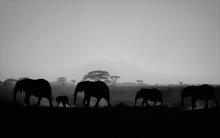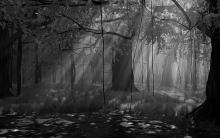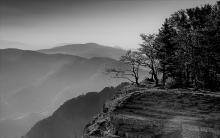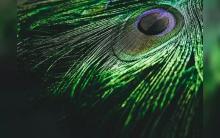तीन बार कुब्ज विष्णुवर्धन ने अपने भाई पुलकेशी के विरुद्ध विद्रोह किया और तीनों ही बार पुलकेशी ने उसे क्षमा कर दिया। न तो वह अपने दुष्ट काका के प्रति आवश्यक कठोरता दिखा पाया और न अपने मनमौजी पुत्रों पर अंकुश रख सका। इन सभी कारणों से दुर्भाग्य पूर्ण परिणाम सामने आये। ऐतिहासिक अभिलेखों के अनुसार काका मंगलेश, कुब्ज विष्णुवर्धन को सदैव पुलकेशी के विरुद्ध भड़काता रहता था। पुलकेशी चाहता तो इन सभी स्थितियों से पूर्णतः स्वयं को बचा सकता था यदि वह निर्णयात्मक ढंग से कार्य करता किंतु उसने वैसा नहीं किया। इन सभी षड्यंत्रों से त्रस्त होकर उसकी दादी ने देह त्याग दिया।
Author:hari
ಕಾವ್ಯ-ನಾಟ್ಯ
ಅನುಭಾವವಿಭಾವಾನಾಂ ವರ್ಣನಾ ಕಾವ್ಯಮುಚ್ಯತೇ |
ತೇಷಾಮೇವ ಪ್ರಯೋಗಸ್ತು ನಾಟ್ಯಂ ಗೀತಾದಿರಂಜಿತಮ್ || (ವ್ಯಕ್ತಿವಿವೇಕ, ಪು. ೯೬)
ಪ್ರಯೋಗತ್ವಮನಾಪನ್ನೇ ಕಾವ್ಯೇ ನಾಸ್ವಾದಸಂಭವಃ ||
ವರ್ಣನೋತ್ಕಲಿಕಾಭೋಗಪ್ರೌಢೋಕ್ತ್ಯಾ[1] ಸಮ್ಯಗರ್ಪಿತಾಃ |
ಉದ್ಯಾನಕಾಂತಾಚಂದ್ರಾದ್ಯಾ ಭಾವಾಃ ಪ್ರತ್ಯಕ್ಷವತ್ ಸ್ಫುಟಾಃ || (ಅಭಿನವಭಾರತೀ, ಸಂ. ೧, ಪು. ೨೯೧-೯೨)
Pātra-prāśastya – Excellence of Character
Pātra-viśeṣanyastaṃ guṇāntaraṃ vrajati śilpam-ādhātuḥ!
Jalam-iva samudra-śuktau muktāphalatāṃ payodasya ॥ Act 1, verse 6
The skill of a teacher who imparts his knowledge to a worthy student attains greater excellence, just as a water droplet from a cloud gets, when it falls into a oyster, gets converted into a precious pearl.
Knowledge and Livelihood
yasyāgamaḥ kevalajīvikāyai
समुद्री घाट क्षेत्र के अनेक शत्रुओं को पुलकेशी ने हराया। उसने अनेक राष्ट्रकूटों पर भी विजय प्राप्त की, उसने सातवाहनों को समाप्त किया, उसने पल्लव वंशी महेन्द्रवर्मा तक को निष्प्रभावी कर दिया। उसने न केवल कांची तक धावा बोला अपितु कन्याकुमारी तक अपनी संप्रभुता को स्थापित किया। समस्त दक्षिण भारत पर अपना नियंत्रण स्थापित करने के उपरांत पुलकेशी ने नर्मदा तट पर हर्षवर्धन को आसानी से हरा दिया। हर्षवर्धन जो ‘उत्तरापथ परमेश्वर’ था पूरे देश का सम्राट बनने की इच्छा से नर्मदा तट तक आगया और वहां उसे ‘दक्षिणापथ परमेश्वर’ पुलकेशी द्वितीय का सामना करना पड़ा था। चूंकि दोनों ही सम
ಕವಿ-ಕಾವ್ಯ
ನಾನೃಷಿಃ ಕವಿರಿತ್ಯುಕ್ತಮೃಷಿಶ್ಚ ಕಿಲ ದರ್ಶನಾತ್ |
ವಿಚಿತ್ರಭಾವಧರ್ಮಾಂಶತತ್ತ್ವಪ್ರಖ್ಯಾ ಚ ದರ್ಶನಮ್ ||
ಸ ತತ್ತ್ವದರ್ಶನಾದೇವ ಶಾಸ್ತ್ರೇಷು ಪಠಿತಃ ಕವಿಃ |
ದರ್ಶನಾದ್ವರ್ಣನಾಚ್ಚಾಥ ರೂಢಾ ಲೋಕೇ ಕವಿಶ್ರುತಿಃ ||
ತಥಾ ಹಿ ದರ್ಶನೇ ಸ್ವಚ್ಛೇ ನಿತ್ಯೇಽಪ್ಯಾದಿಕವೇರ್ಮುನೇಃ |
ನೋದಿತಾ ಕವಿತಾ ಲೋಕೇ ಯಾವಜ್ಜಾತಾ ನ ವರ್ಣನಾ || (ಕಾವ್ಯಾನುಶಾಸನ, ಪು. ೪೩೨)
In the characters of Queen Dhāriṇī and Irāvatī, we can see the abhinaya of mature and experienced women; there is a difference of flavour in them. Dhāriṇī is the queen and she carries herself with the kind of dignity and majesty expected of the royalty; Irāvatī is probably younger to Dhāriṇī; she is, in a sense, inferior to the queen in the profundity and seriousness of character; she gives herself to pleasure, jealousy, and anger. It appears like Dhāriṇī had kept Mālavikā in prison only to please Irāvatī.
हर दृष्टि से सनातन धर्म, बौद्ध धर्म की तुलना में श्रेष्ठ है। यह सनातन धर्म की श्रेष्ठता का ही प्रतिफल है कि उससे बौद्ध धर्म का जन्म हुआ किंतु बौद्ध धर्म में अपने समतुल्य या अपने से श्रेष्ठ संप्रदाय को उत्पन्न कर पाने की क्षमता नही रही। यही कारण है कि उससे वज्रयान, सहजयान, महाचीन और गुह्यसमाज जैसे छुटषुट मत पैदा होते रहे। इसके विपरीत सनातन धर्म का शताब्दियों पूर्व की लम्बी परम्परा रही है इस परम्परा ने परम शांति तथा आत्म तत्त्व के दर्शन से संयुक्त एक ऐसे विश्राम स्थल का निर्माण किया है जंहा किसी भी बहुमुखी समाज को समाविष्ट करने का क्षमता रही है।
ಭಾರತೀಯ ಕಾವ್ಯಮೀಮಾಂಸೆ ಮತ್ತು ಕಲಾಮೀಮಾಂಸೆಗಳ ಕ್ಷೇತ್ರದಲ್ಲಿ ಭಟ್ಟತೌತನ ಹೆಸರು ಅಜರಾಮರ.[1] ಕಾಶ್ಮೀರದಲ್ಲಿ ಬಾಳಿ ಬೆಳಗಿದ ಈ ವಿದ್ವದ್ವಿಭೂತಿ ಒಂಬತ್ತು-ಹತ್ತನೆಯ ಶತಮಾನಗಳ ಆಸುಪಾಸಿನಲ್ಲಿ ಇದ್ದವನೆಂದು ತಿಳಿದುಬರುತ್ತದೆ. ಈತನ ‘ಕಾವ್ಯಕೌತುಕ’ದ ಹೊರತಾಗಿ ಮತ್ತಾವ ಗ್ರಂಥದ ಕುರುಹೂ ನಮಗೆ ಉಳಿದಿಲ್ಲ. ಇದಾದರೂ ನಮಗಿಂದು ಸಿಕ್ಕಿಲ್ಲ. ಕೇವಲ ಅವರಿವರು ಉದ್ಧರಿಸುವ ಶ್ಲೋಕಭಾಗಗಳಿಂದ ನಮಗೆ ಈ ಕೃತಿಯ ಮಹತ್ತ್ವ ತಿಳಿಯುತ್ತಿದೆ.[2] ಹೀಗೆ ತಿಳಿದಾಗ ನಾವೆಂಥ ಅದ್ಭುತ ಶಾಸ್ತ್ರನಿಧಿಯನ್ನು ಕಳೆದುಕೊಂಡೆವೆಂಬ ದುಃಖ ಉಮ್ಮಳಿಸಿ ಬರದಿರದು.
ಕಾವ್ಯಾನುಶಾಸನದ ಕೆಲವು ವೈಶಿಷ್ಟ್ಯಗಳು
ಗ್ರಂಥಗತ ವಿಷಯಗಳನ್ನು ಪರಿಚಯಿಸಿಕೊಂಡ ಬಳಿಕ ಇಲ್ಲಿಯ ಕೆಲವು ವೈಶಿಷ್ಟ್ಯಗಳನ್ನೂ ಅಲಂಕಾರಶಾಸ್ತ್ರದಲ್ಲಿ ಇದರ ಸ್ಥಾನವನ್ನೂ ಅರಿಯಲು ತೊಡಗಬಹುದು.






